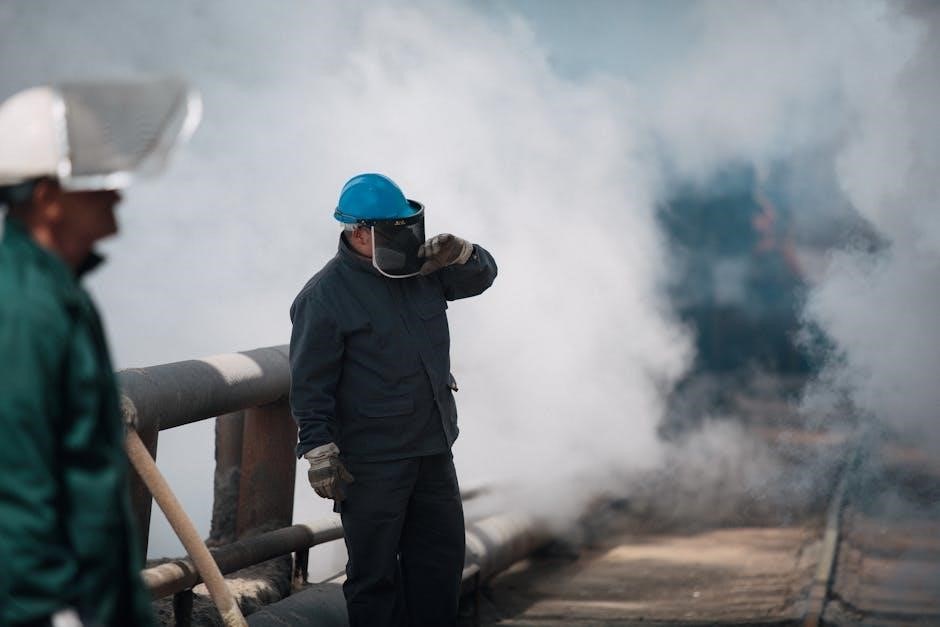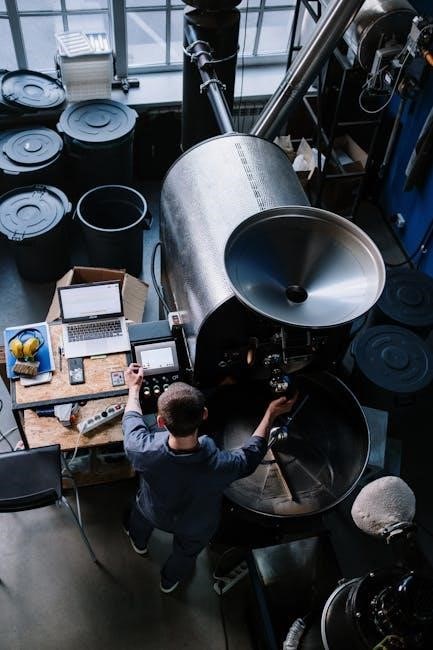This manual provides essential guidance for installing, operating, and maintaining Panasonic ducted air conditioning systems. It ensures safe and efficient use, covering key features and troubleshooting tips.
1.1 Overview of the Manual
This manual is a comprehensive guide for Panasonic ducted air conditioning systems, detailing installation, operation, and maintenance. It covers essential steps for proper setup, including piping work and electrical connections, to ensure efficient performance. The manual also outlines safety precautions, such as handling guidelines and disposal instructions, to protect users and service personnel. Additionally, it provides troubleshooting tips and error code solutions, helping users resolve common issues independently. Technical specifications, including cooling and heating capacities, are included to inform model selection. The manual emphasizes the importance of regular maintenance, such as air filter cleaning and coil care, to prolong system longevity. Remote control usage and temperature functions are explained for seamless operation. By following this manual, users can optimize their system’s performance and safety.
1.2 Importance of Reading the Manual
Reading the Panasonic ducted air conditioning manual is crucial for ensuring safe and efficient system operation. It highlights potential hazards and provides clear guidelines to avoid accidents. Proper installation and maintenance procedures are detailed to prevent issues like condensation and piping imperfections. The manual also explains error messages and warnings, enabling users to address problems promptly. Understanding the manual’s instructions ensures optimal performance, energy efficiency, and longevity of the system. Additionally, it outlines warranty terms and manufacturer support, helping users navigate technical challenges. By following the manual, users can avoid costly repairs and maintain a comfortable indoor environment. It is essential for both homeowners and technicians to adhere to the guidelines for safe and effective use of the system.

Installation Requirements
The manual outlines essential installation steps, including pre-installation checks, piping work guidelines, and electrical connections. Proper thermal insulation is required to prevent condensation issues during operation.
2.1 Pre-Installation Checks
Before installing your Panasonic ducted air conditioning system, ensure the site is prepared and all necessary components are available. Conduct a thorough inspection of the area to verify compatibility with the system’s specifications. Check for any obstructions or structural issues that could hinder installation. Ensure proper thermal insulation materials are ready to prevent condensation during operation. Verify that all electrical connections and piping routes are planned according to the manual’s guidelines. Confirm that the indoor and outdoor units are compatible and suitable for the space. Additionally, ensure that the system’s cooling and heating capacities match the room’s requirements. Always follow the manufacturer’s recommendations to guarantee a safe and efficient installation process.
2.2 Piping Work Guidelines
Proper piping installation is crucial for the efficient operation of your Panasonic ducted air conditioning system. Ensure all pipes are insulated to prevent condensation and energy loss. Use the correct piping materials and sizes as specified in the manual to maintain optimal performance. Avoid sharp bends and kinks in the piping, as they can restrict refrigerant flow. Ensure that the piping is securely fastened to prevent vibration and damage. Follow the recommended routing to minimize interference with other systems. Properly seal all connections to prevent leaks and test the system for any defects before finalizing the installation. Adhering to these guidelines will ensure reliable and efficient system performance while minimizing potential issues during operation.

2.3 Electrical Connections and Requirements
Ensure all electrical connections for your Panasonic ducted air conditioning system are installed by a licensed technician. Use the correct power supply as specified in the manual to avoid damage or safety risks. Connect the system to a dedicated circuit to prevent overload and ensure stable operation. Check that all wiring matches the system’s voltage and current requirements. Securely tighten all connections to prevent loose contacts, which can cause malfunction or fire hazards. Install a suitable circuit breaker or switch to control power supply. Follow local electrical codes and safety standards. Proper grounding is essential to protect against electrical shocks. Regularly inspect wiring and connections for wear or damage. Adhere to these guidelines to ensure safe, efficient, and reliable system performance.

Operating the Panasonic Ducted Air Conditioning System
Learn to operate your Panasonic ducted system efficiently with the wall controller or remote. Adjust modes, temperatures, and timers for optimal comfort and energy savings.
3.1 How to Use the Wall Controller
To operate the Panasonic ducted air conditioning system, start by locating the wall controller. Press the power button (often marked with a circle and line) to turn the system on or off. Adjust the temperature using the up and down arrows. Switch between cooling and heating modes by pressing the button with a snowflake and sun icon. Control fan speed by pressing the fan icon button, which cycles through different settings. Set timers using the clock icon button and arrows to schedule operations. The ‘Eco’ button enables energy-saving mode, while the padlock icon locks the controller to prevent accidental changes. Experiment with these features to optimize comfort and efficiency.
3.2 Mode Selection (Cooling, Heating, etc.)
The Panasonic ducted air conditioning system offers various operating modes to suit different needs. Press the mode button on the wall controller to cycle through available options: Cooling mode (snowflake icon) lowers the room temperature, while Heating mode (sun icon) raises it. The Dry mode (water droplet icon) reduces humidity without cooling, ideal for rainy days. Fan mode (fan icon) circulates air without heating or cooling. Auto mode (A icon) automatically selects the appropriate mode based on the set temperature. Use these modes to maintain comfort and energy efficiency. Each mode is designed for specific conditions, ensuring optimal performance and personalized comfort.
3.3 Remote Control Usage and Range
The Panasonic ducted air conditioning system comes with a remote control for easy operation. The remote allows users to adjust settings like temperature, mode, and fan speed from a distance. Ensure the remote has a clear line of sight to the indoor unit for optimal functionality. The operating range is typically up to 10 meters, depending on obstacles like walls or furniture. Replace the remote batteries when the signal weakens, usually requiring two AAA batteries. Store the remote in a dry place to prevent damage. For troubleshooting, ensure the remote is paired correctly with the system. Refer to the manual for syncing instructions if the connection is lost.
3.4 Understanding Temperature and Timer Functions
The Panasonic ducted air conditioning system allows precise temperature control, enabling users to set their desired comfort level. The temperature range typically spans from 15°C to 30°C, depending on the model. Use the wall controller or remote to adjust settings effortlessly. The timer function lets you schedule operations, turning the system on or off at specific times. This feature is ideal for energy efficiency, ensuring the system runs only when needed. Some models offer a “hold” function to maintain a constant temperature. For advanced customization, refer to the manual for programming instructions. Proper use of these functions optimizes performance and energy savings, making your system more convenient and eco-friendly.
Technical Specifications
This section outlines the system’s technical details, including model-specific performance metrics, cooling and heating capacities, and operational parameters, ensuring compatibility with various installation and usage requirements.
4.1 Model-Specific Details
This section provides detailed information about the various Panasonic ducted air conditioning models, including their unique features, dimensions, and performance capabilities. Each model is designed to cater to different space requirements and energy efficiency needs. Key specifications such as cooling and heating capacities, airflow rates, and power consumption are highlighted. The manual also covers advanced technologies like inverter compressors and smart sensors, which enhance system efficiency and user comfort. Additionally, it outlines compatibility with different ducting systems and installation configurations, ensuring optimal performance in various environments. This section helps users identify the most suitable model for their specific application, making it easier to plan and execute installation and operation effectively. Proper model selection ensures energy savings and long-term reliability.
4.2 Cooling and Heating Capacities

This section outlines the cooling and heating capacities of Panasonic ducted air conditioning systems, ensuring optimal performance for various spaces. Capacities are measured in kilowatts (kW) and vary across models to suit different room sizes and climate conditions. The manual provides detailed charts to help users determine the appropriate capacity for their needs. Factors such as insulation, window size, and external temperatures are considered to ensure efficient operation. Panasonic systems are designed to deliver consistent cooling and heating, with capacities ranging from small residential units to larger commercial setups. Proper capacity selection ensures energy efficiency and comfort, making it crucial to match the system to the space it serves. This section guides users in making informed decisions for their specific requirements. Always refer to the model-specific data for precise capacity ratings.
4.3 Noise Levels and Operation
Panasonic ducted air conditioning systems are designed to operate quietly, ensuring minimal disturbance in both residential and commercial environments. The outdoor unit is typically placed away from living spaces, reducing noise impact; Indoor units feature advanced fan motors and insulation, resulting in low operational noise levels. The manual provides decibel ratings for various models, allowing users to choose systems that align with their comfort needs. Quiet operation is a hallmark of Panasonic systems, enhancing overall user experience without compromising performance. This section helps users understand noise levels during different modes, such as cooling, heating, and fan-only operation. Proper installation, as outlined in the manual, further ensures optimal noise reduction and smooth system performance.

Safety Precautions
Always follow safety guidelines to avoid accidents. Ensure proper installation and operation to prevent electrical hazards. Regular maintenance is crucial for safe and efficient system performance.
5.1 Handling and Storage Guidelines
Proper handling and storage of Panasonic ducted air conditioning components are essential to ensure system integrity and safety. Avoid exposing units to direct sunlight, moisture, or extreme temperatures. Store components in their original packaging until installation to prevent damage. Handle refrigerant lines with care to avoid bending or puncturing. Ensure all electrical components are kept dry and away from flammable materials. Use appropriate lifting equipment for heavy parts to prevent physical strain or damage. Follow manufacturer guidelines for storing spare parts and accessories. Always maintain a clean and stable storage environment to preserve component quality. Improper handling or storage may lead to system damage or safety hazards.
5.2 Disposal Instructions
Proper disposal of Panasonic ducted air conditioning components is crucial for environmental protection. Refrigerants must be handled by certified professionals to prevent atmospheric release. Disconnect power and drain fluids before disposal. Secure all sharp edges and components to avoid injury. Dispose of packaging materials responsibly, recycling where possible. Do not dispose of units in landfills without proper treatment; Contact local authorities for regulations on appliance disposal. Ensure all hazardous materials are handled by authorized facilities. Improper disposal may harm the environment or violate regulations. Always follow eco-friendly practices and manufacturer guidelines for safe disposal. This ensures compliance with environmental standards and promotes sustainability.
5.3 Error Messages and Warnings
The Panasonic ducted air conditioning system displays error messages to indicate malfunctions or unusual operating conditions. These messages are essential for diagnosing issues promptly. Common error codes include ‘E1’ for sensor malfunctions, ‘E2’ for refrigerant issues, and ‘E3’ for communication errors. Always refer to the manual for specific code interpretations. If an error occurs, turn off the system and unplug it to prevent further damage. Do not attempt repairs unless you are qualified, as this may void the warranty or cause safety risks. Contact a certified technician for professional assistance. Ignoring warnings may lead to system failure or safety hazards. Regular maintenance can help prevent errors and ensure smooth operation.
Troubleshooting Common Issues
Identify and resolve common problems like system not turning on, uneven cooling, or strange noises. Check power supply, ensure proper installation, and clean air filters regularly. Consult the manual or contact support for persistent issues.
6.1 Common Operational Problems
Common issues with Panasonic ducted air conditioning systems include the unit not turning on, uneven cooling, or strange noises. These problems often arise from power supply issues, incorrect thermostat settings, or blocked air vents. Air leaks in the ductwork can also reduce efficiency and cause temperature inconsistencies. Additionally, sensor malfunctions or faulty remote controls may disrupt operation. Users should first check the power supply, ensure filters are clean, and verify that all vents are open. If problems persist, consulting the manual or contacting a certified technician is recommended. Regular maintenance, such as cleaning filters and inspecting ducts, can prevent many of these issues. Always refer to the manual for specific troubleshooting steps.
6.2 Error Codes and Their Solutions
Panasonic ducted air conditioning systems display error codes to indicate specific issues. Common codes include E1 (sensor malfunction), E2 (refrigerant issues), and E3 (communication errors). For E1, check and clean sensors or replace them if damaged. E2 may require professional inspection of refrigerant levels or leaks. E3 often resolves by restarting the system or checking wiring connections. Refer to the manual for a full list of codes and solutions. Always turn off power before attempting repairs. If unresolved, contact a certified technician to avoid further damage. Regular maintenance can help prevent these issues and ensure optimal system performance.
Maintenance and Service
Regular maintenance ensures optimal performance and extends system lifespan. Clean air filters monthly, inspect condenser coils, and check drainage systems. Schedule professional servicing annually for best results.
- Clean or replace air filters regularly.
- Inspect condenser coils for dirt or damage.
- Ensure proper drainage to prevent water buildup.
7.1 Air Filter Cleaning and Replacement
Regular air filter maintenance is crucial for optimal system performance. Clean or replace filters monthly to ensure proper airflow and energy efficiency. Turn off the system before servicing. Gently remove filters, vacuum, or wash with mild detergent if reusable. Replace disposable filters with Panasonic-approved ones. Dirty filters reduce cooling capacity and increase energy bills. Always follow the manual’s instructions for filter access and handling. Proper maintenance prevents dust buildup, improves indoor air quality, and extends system lifespan. Schedule filter checks every 1-2 months during heavy use. Replace filters every 3-6 months or as recommended. Clean filters ensure consistent airflow and maintain system efficiency;
- Clean filters monthly for optimal performance.
- Replace disposable filters every 3-6 months.
- Use Panasonic-approved filters for best results.
- Turn off the system before cleaning or replacing filters.
7.2 Coil and Condenser Maintenance
Regular cleaning of the evaporator and condenser coils is essential for maintaining efficiency and performance. Dirt buildup reduces heat transfer, increasing energy consumption and wear on the system. Clean the coils every 3-6 months using a soft brush or garden hose on a low setting. Ensure the system is turned off before cleaning to avoid damage. Straighten bent fins carefully with a fin comb to improve airflow. Inspect and clean the condenser unit regularly, especially after storms or pollen seasons. Proper coil maintenance ensures optimal cooling, reduces energy bills, and prolongs system lifespan. Trim nearby plants to prevent debris accumulation. For deep cleaning, consult a professional to avoid damage.
- Clean coils every 3-6 months for efficiency.
- Use a soft brush or low-pressure hose.
- Turn off the system before cleaning.
- Check for bent fins and straighten them.
- Trim plants to reduce debris buildup.
7.3 Drainage System Management
Proper drainage system maintenance is crucial for the smooth operation of your Panasonic ducted air conditioning system. Regularly inspect the drain hose and pan for blockages, kinks, or water accumulation. Clean the drain hose using a wet vacuum or soft brush to remove dirt and debris. Check for any signs of rust or corrosion in the drain pan and replace it if necessary. Ensure the drain is properly sloped to allow water to flow freely. If water leakage occurs, turn off the system and contact a professional. Clean the drainage system every 6 months to prevent mold growth and water damage. Regular maintenance ensures efficient operation and prevents potential breakdowns.
- Inspect drain hose and pan for blockages.
- Clean drain hose with a wet vacuum or brush.
- Check for rust or corrosion in the drain pan.
- Ensure proper slope for water flow.
- Clean the system every 6 months.

7.4 Scheduled Service Intervals
Regular servicing is essential to maintain the performance and longevity of your Panasonic ducted air conditioning system. Schedule professional maintenance every 12 months, or as recommended by the manufacturer. During these services, technicians will inspect and clean the air filters, coils, and condenser units. They will also check refrigerant levels, drainage systems, and electrical connections. Additionally, ensure minor maintenance tasks, such as filter cleaning, are done every 1-3 months. Neglecting scheduled servicing can lead to reduced efficiency, higher energy bills, or system breakdowns. Always refer to the manual for specific service intervals and adhere to them for optimal system operation and warranty compliance.
- Schedule professional maintenance every 12 months.
- Inspect and clean air filters, coils, and condensers.
- Check refrigerant levels and electrical connections.
- Clean filters every 1-3 months for efficiency.
- Adhere to manual recommendations for optimal performance.

Additional Resources

Explore Panasonic’s official website for comprehensive guides, troubleshooting tips, and customer support details to enhance your ducted air conditioning experience and resolve queries efficiently.
8.1 Downloading the Full Manual
Access the full Panasonic ducted air conditioning manual by visiting the official Panasonic website. Navigate to the “Support” or “Downloads” section, where you can search for your specific model. Enter your product details, such as the model number, to locate the manual. Ensure you select the correct language and region to download the appropriate version. Once found, click the download link to save the PDF file. The manual is available in multiple formats, including PDF, for easy viewing on desktops, tablets, or smartphones. For the most accurate and updated information, always refer to the official Panasonic website. This ensures you have the latest guidelines and specifications for your system.
If you cannot find the manual online, contact Panasonic customer support for assistance. They can provide direct links or email the document to you. Always verify the source to avoid downloading unofficial or outdated versions.

8.2 Manufacturer Support and Contact Information
For assistance with your Panasonic ducted air conditioning system, contact Panasonic’s customer support team. Visit the official Panasonic website and navigate to the “Support” section to find contact details, including phone numbers, email addresses, and live chat options. Depending on your location, regional offices may provide localized support. The website also offers a comprehensive FAQ section and troubleshooting guides. For technical inquiries or service requests, use the online contact form. Panasonic’s dedicated support team is available to address installation, operation, or maintenance concerns. Ensure to have your product model number ready for efficient assistance. This service is designed to provide prompt and reliable solutions for optimal system performance.
8.3 User Forums and Community Discussions
Panasonic ducted air conditioning users can benefit from active user forums and community discussions. These platforms allow homeowners and professionals to share experiences, ask questions, and provide tips for installation, maintenance, and troubleshooting. Many forums are dedicated to specific Panasonic models, offering tailored advice. To access these resources, visit Panasonic’s official website or popular DIY and HVAC forums. Use search terms like “Panasonic ducted air conditioning forum” or “user community” to find relevant discussions. These communities often include insights from experienced technicians and satisfied customers, making them invaluable for optimizing system performance and resolving common issues. Regularly updated threads ensure access to the latest information and solutions.
8.4 Warranty Information
Panasonic offers comprehensive warranty coverage for its ducted air conditioning systems, ensuring peace of mind for users. The standard warranty typically includes parts and labor for a specified period, often 5 years for parts and 1 year for labor. Extended warranties may be available for additional coverage. To maintain warranty validity, ensure all installations and repairs are performed by authorized Panasonic technicians. Improper installation or unauthorized modifications can void the warranty. For warranty claims, contact Panasonic’s customer support team with proof of purchase and installation details. Visit the Panasonic website for full warranty terms and conditions, or refer to the provided warranty card in the product packaging.
